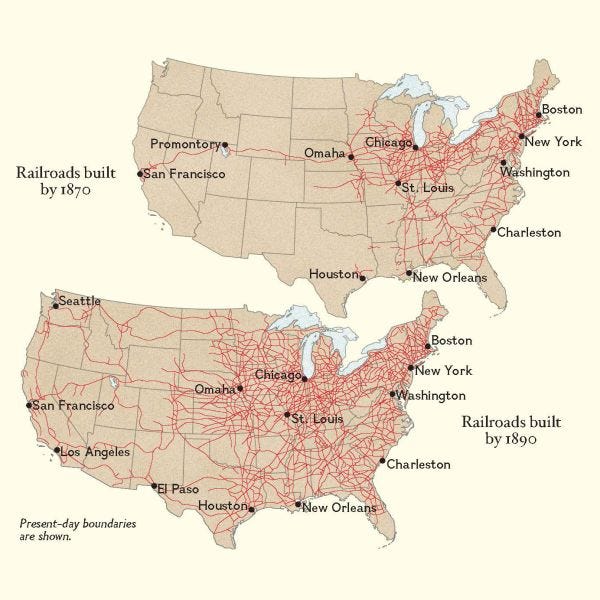A Brief History of SaaS and What's Next
Software ate the world and then ate itself. What comes next?
I’ll summarize the entirety of this essay as succinctly as possible, so if you’re more interested in the conclusions you can read it here. The rest just elaborates and gives examples.
The relationship between return-seeking capital and new technology development produces cycles that follow regular phases - early adoption, deployment, over-investment and speculation, and finally collapse into a commodity.
The collapse of new technology sectors from high-returns to commodities netting average returns sets the ground-work for the next wave of technological innovation. What was once high-tech becomes background infrastructure enabling the next cycle of innovation.
Some examples are:
steam engines → age of rail
age of rail → age of heavy manufacturing / electricity
age of electricity → telecommunications networks
telecommunications → digital IT economy.
SaaS / Software is in general one such category of high-returning tech that will soon approach commodity-like returns. The ‘thing’ it enables next is: artificial intelligence, robotics, biotech, and reforming manufacturing and space.
This is not my theory, its taken directly from Carlotta Perez’s must-read book, “Technological Revolutions and Financial Capital: The Dynamics of Bubbles and Golden Ages”, and adapted to a forward-looking perspective on the current SaaS market and the coming Golden Age of Deep Tech. If you haven’t read Perez yet, you should - its well researched, approachable, and insightful.
With that context in mind, lets take a look at where things are today.
Sea Changes in Blue Ocean SaaS
Here’s my quick synthesis of things I’ve heard, read, and thought of on the changing SaaS landscape: the number of new venture-scale software opportunities is shrinking outside of strong network effects as software reaches better overall penetration and barriers to entry continue to drop. Current whale-sized ventures might also see their margins, and therefore revenue-based valuation multiples, eaten away by a sea of bootstrapped piranhas - historically high net margins in SaaS were an arbitrage on two things: limited developer talent, and the cost to deploy and scale SaaS services. Talent shortages and low market penetration of software-internet services enabled winner-take all dynamics in large markets - there was no real incumbents, and those who scaled quickly via venture capital captured the whole pie, built barriers to entry, and could then sit pretty to command large amounts of recurring revenue at high margins. A gold rush to make any 49’er proud.
The wedge for newcomers is that frequently winner-take-all dynamics create one-size-fits-all badly products, despite those products clear delivery of high value above past alternatives. Consider how many industries have unique demands for their CRM, and how many use Salesforce because its ‘good enough,’ and often better than others, but not ideally adapted to that specific niche. The thesis that AI-boosted software development lowers activation costs directly for software companies is certain at the early-stage, iterative prototyping phase, while products find their market fit - that LLM’s can more generally shift the unit economics of later growth stage companies by supplementing sales, marketing, customer support and administrative tasks seems assured in the very near future if not already.
The net effect: more granular market segmentation of software specific use-cases as unit economics and defensibility shift to favor highly-customized, adapted solutions to specific niches, carving up a more-slowly-growing pie into finer absolute-sized slices. On the near-side of an LLM API call, a massive number of red-ocean opportunities that each have relatively low funding requirements past an initial pre-seed or angel round before sprinting to cash flow profitability; on the far side, vanishingly few credible opportunities for massive companies raising billions at extreme valuations.
Where is this all going and what port can good capital go in a storm? The world-spanning saturation of software that lubricates the wheels of the economy in a thousand invisible ways adds to the bottom-line prosperity of everyone, but more importantly, the construction and mass-production of highly sophisticated data center networks and computing centers enables fundamentally new technological frontiers, and like any gold rush the highest yields are likely to come from the least-mined regions of new tech development.
The coming golden age in artificial intelligence, biotechnology, robotics, additive manufacturing, space systems, longevity and more are all built on the commodification of powerful, robust and mature software and digital infrastructure built up through past periods of growth, speculation, and frenzied over speculation. As the hangover of a speculative ZIRP-era funding every dog-walking-app and uber-for-swimming pools, investors look to a new frontier in the space of atoms.
There’s a general pattern here worth understanding.
Financial Capital and the Structure of Golden Ages
To get a feeling for this pattern in the relationship between financial capital and industrial development over the last 200 years, here’s a short story about trains.
Railway transportation for freight and passengers first took off in the 1820s and 1830s - the Stockton, Darlington, Liverpool and Manchester railways were constructed, demonstrating the viability and reliability of long distance rail. Trains were far superior to the current incumbent, donkey-pulled canal barges: rail lines were constructed at far lower cost, offered far higher speeds, greater reliability, and flexibility in routing through a given geography.
During the 1850s in the US railroad magnates emerged with names like Cornelius Vanderbilt, Leland Stanford and Andrew Carnegie, who had built vast fortunes by constructing, consolidating and supplying a booming railroad industry. Always in search of a good return, investors flocked to the purchase of railroad bonds to finance and receive equity in new railroad lines, driving a speculative frenzy far in-excess of real or projected freight demand.
Rail mania swept the nation until the Panic of 1873 saw the collapse of Jay Cooke & Company, a major bank involved in the financing of railroads, leading to a domino effect that cause the Long Depression in Europe until 1879. Then again, in 1893 another 500 banks in the US closed for similar reasons - speculation and over-building of rail lines with shaky financing driving bank runs, then large unemployment and overall economic depression.
Post ‘great panics’ the railroad industry continued to grow, through more steady adoption, consolidation, as more competitors entering newly opened markets they drove down each others margins. Before long railroad freight become more of a commodity, and Andrew Carnegie and other magnates diversified into steel, petroleum, manufacturing and other emerging sectors that were to a large extent enabled by the reliability, speed, and density of a mature rail network.
Today, trains basically suck - they’re expensive, slow, and the vast majority of land freight in the US travels by truck. But trains teach us something important - the process by which new tech becomes boring enables the next generation of new, exciting tech, by both reducing the fundamental cost-basis of industrial activity while also opening up categorically new capacities - like timely national supply chains and the mass-production of automobiles.
There’s been a few of these revolutions so far, here’s a handy chart:
Carlotta Perez, the original author of this general theory of financial investment and economic development, published her book in 2002 in the immediate wake of the dot-com bubble. An important part of her theory is the over-speculative ‘turning point’ - the speculative bubble - marks the end of a speculative and naive growth phase and heralds the beginning of the true golden age, when people reap the full fruits as the productive leverage of increasingly commodified technology makes its way into every aspect of our lives and economy.
Much like the two Great Panics in the train startup-scene in the 1870s and 1890s, software has undergone two similar frenzy cycles - one in 2001 with the dot-com era, and a second arguably between 2017-2021 when prolonged low interest rates drove fast-and-loose investments into questionable value propositions at anxiously-comical valuations.
What has Software really done for us?
The magic of software is to imbue our built environment with intelligence - machines that can sense, react, decide, and carry out instructions with methodical precision. This software intelligence has evolved from the specialized-scalpel of the earliest computers that strictly crunched numbers and solved equations, to the more general pickup-truck of shuttling information between buyers and sellers in the Oracle age of SQL databases, to the era of SaaS like Salesforce providing productivity software or social media and internet marketplaces, and to our current frontier of granting actual human-like intelligence and autonomy to physical robots and distributed software systems.
Software magic first developed and perfected for large-scale, highly niche enterprise applications developed the fundamental hardware building blocks that enabled the personal computer age, and consumer appetite for software, from email to video games, again drove further economies of scales in computing hardware like graphics processors, internet data centers and satellite communications systems. The learning rate in cost reduction that comes through larger total production volumes again feeds back into industry, enabling a radically cheap era of IoT sensor devices, robotic actuators, and most importantly, the compute scale and data volume required for producing general artificial intelligence.
The final culmination of this software era is producing something that commodifies the production of software itself - the code-aware LLM, today at the level of an assistant, and perhaps soon likely the lead developer on enterprise-grade applications. Just like railroads paved the road for their automobile replacements, software and networked data centers have given rise to something that replaces software altogether, AI, which can now inhabit the digital nervous system of our world-spanning economy.
The Next Golden Age of Atoms
A great deal of human flourishing awaits us post ‘turning point’ in software, as commodification of software production itself lets loose a maturation and saturation of every market niche. This isn’t just more dollars in the pockets of private enterprise, but a broad-based democratization of the traditional means of achieving ones potential in an ostensibly meritocratic liberal democracy - access to education and tutoring, timely and affordable heath care, accounting and legal services, and more than just unblock altogether boost a persons potential and reach with the kind of concierge personal assistants once the luxury of the wealthy. This commodification of best-in-class personal services comes a few decades after the commodification of best-in-class consumer hardware, where a middle class American can afford the best phone in the world.
This is all just the outcome of the mature deployment phase, the “Golden Age” itself. What cycles are enabled next? Let’s think through a few areas uniquely enabled by this software-intelligence revolution that could each provide a new growth curve and tech-tree unlock in years to come.
Robotics and Automation
There are two big trends driving the revolution in robotics today - one is general advancements in making dense, accurate and high power-to-weight ratio actuators for mobility in conjunction with more efficient and power-dense battery cells - the physical bits that move and power the moving. But the hard part of robots isn’t making them move, it’s making them move correctly. Developing a robust enough ‘world model,’ or ability to interpret and reason accurately about general situations that haven’t previously been encountered, is what brings you from a robot that can perform a repetitive manufacturing task to one that can do your chores around the house without being asked.
The continued miniaturization of electronics, sensors, higher compute densities and model performances first achieved for consumer electronics that house our software information landscapes now sets the stage for the economic production of robust, competent general purpose human robots, both in the home and every corner of industry.
From Big Data Science comes Biotech
Currently genome sequencing is getting cheaper at a faster rate than transistors, largely enabled by the Next-Generation Sequencing pioneered by Illumina. This sequencing method involves taking a single gene library, making innumerous copies, then randomly slicing it into small snippets before reading each snippet in parallel. Large-scale compute re-assembles the entire genome faster and cheaper than the previous modality, Sanger Sequencing used by the Human Genome Project. The HGP total cost was $3 billion, today you can sequence a genome for $200, a full nine orders of magnitude cost reduction.
This is just the beginning - single-cell sequencing, proteomics, transcriptomics, mass spectrometry, light sheet microscopy all rely on large amounts of cheap compute, data storage, and network bandwidth to answer fundamental questions in cell biology. Already life science data production has overtaken all other sources of data production on the planet in raw TB quantities, and the breadth and depth of data collection might one day be embedded in the latent space of a grand AGI able to speak natively the programming language of DNA and protein compilation.
Accelerated Design and Manufacturing
As of the day I write this post my day job is designing components and systems for a stellarator magnetic confinement fusion device. Unlike writing software in a text-based language, programming physical designs involves endless GUI-based point and click actions. Though computer-aided design tools have come along way since the early days of AutoCad, 90% of the designers time is still spent trying to translate their intention into a software-defined geometry. It’s difficult, pain consuming, and tedious - and in ripe need of disruption with a more intuitive geometry-based foundation model.
Design is one thing - manufacturing is harder. Reconfigurable modular manufacturing methods, also enabled by the commodification of sensors, electronics, and compact compute, in additive manufacturing and optimized tooling have the potential to bring a fluidity to physical product lines previously only seen in the world of build-fast, deploy-cheap software upgrades. Building out the cheap, durable, and flexible tooling of modular manufacturing and accelerated design tools is itself a lucrative market, and begins another long arc of tech development that ends in the Star Trek Replicator.
Rockets That Think
This one’s easy. A rocket that thinks is a rocket that can land itself. What does this do for space? Unlocks entirely new categories of economically viable activities, and we see it today already. Just look at the entire New Space industry, built on the back of the Falcon 9 and its cost-to-LEO.
The commodification of software intelligence that imbues our built environment is one miracle unlock. The creation of a hardened veteran class of tech builders who cut their teeth and built their fortunes in the software era is another thing altogether. It’s to our collective benefit that the heroes of one Golden Age choose good quests for the next.












Your "Thanks for reading Ulysses!" made me chuckle after my last post: https://constantinemarkides.substack.com/p/rogue-7-james-joyce
Insightful, it seems like moats as we know them will cease to exist